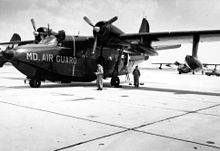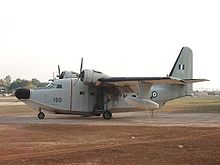- Grumman HU-16 Albatross
-
HU-16 Albatross Restored US Navy HU-16C BuNo 131906, built June 1953 Role Air-sea rescue flying boat Manufacturer Grumman First flight October 24, 1947[1] Introduction 1949 Retired 1995 (Hellenic Navy) Primary users United States Air Force
United States Coast Guard
United States Navy
Hellenic NavyProduced 1949-1961 Number built 466 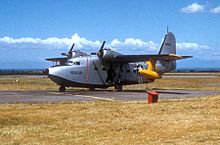 An USAF SA-16A during the Korean War.
An USAF SA-16A during the Korean War.
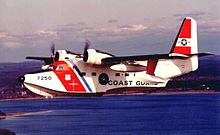 U.S. Coast Guard HU-16E from CGAS Cape Cod in the 1970s.
U.S. Coast Guard HU-16E from CGAS Cape Cod in the 1970s.
The Grumman HU-16 Albatross is a large twin-radial engine amphibious flying boat that was utilized by the U.S. Air Force, the U.S. Navy and the U.S. Coast Guard, primarily as a search and rescue and combat search and rescue aircraft. Originally designated as the SA-16 for the USAF and the JR2F-1 and UF-1 for the USN and USCG, it was redesignated as the HU-16 in 1962.
Contents
Design and development
An improvement of the design of the Grumman Mallard, the Albatross was developed to land in open ocean situations to rescue downed pilots. Its deep-V cross-section and substantial length enable it to land in the open sea. The Albatross was designed for optimal 4 ft seas, and could land in more severe conditions, but required JATO for takeoff in 8-10 ft seas or greater.
Since the aircraft weighs over 12,500 pounds, pilots of civilian US-registered Albatross aircraft must have a type rating. There is a yearly Albatross fly-in at Boulder City, Nevada where Albatross pilots can become type rated.
Operational history
The majority of Albatrosses were used by the U.S. Air Force, primarily by the former Air Rescue Service, and initially designated as SA-16. The USAF utilized the SA-16 extensively in Korea for combat rescue, where it gained a reputation as a rugged and seaworthy craft. Later, the redesignated HU-16B (long-wing variant) Albatross was used by the U.S. Air Force's Aerospace Rescue and Recovery Service and saw extensive combat service during the Vietnam War. In addition a small number of Air National Guard Air Commando Groups were equipped with HU-16s for covert infiltration and extraction of special forces from 1956 to 1971.[2]
The U.S. Navy also employed the HU-16C/D Albatross as a Search and rescue (SAR) aircraft from coastal naval air stations, both stateside and overseas. It was also employed as an operational support aircraft worldwide and for "skunk runs" from the former NAS Agana, Guam during the Vietnam War. Goodwill flights were also common to the surrounding Trust Territory of the Pacific Islands in the early 1970s. Open water landings and water takeoff training using JATO was also conducted frequently by U.S. Navy HU-16s from locations such as NAS Agana, Guam; Naval Station Guantanamo Bay, Cuba; NAS Barbers Point, Hawaii; NAS North Island, California, NAS Key West, Florida; NAS Jacksonville, Florida and NAS Pensacola, Florida, among other locations.
The HU-16 was also operated by the U.S. Coast Guard as both a coastal and long-range open ocean SAR aircraft for many years until it was supplanted by the HU-25 Guardian and HC-130 Hercules.
The final USAF HU-16 flight was the delivery of AF Serial No. 51-5282 to the National Museum of the United States Air Force at Wright-Patterson AFB, Ohio in July 1973 after setting an altitude record of 32,883 ft earlier in the month. The final US Navy HU-16 flight was made 13 August 1976 when an Albatross was delivered to the Naval Aviation Museum at NAS Pensacola, Florida. [3] The final USCG flight of the Albatross was at CGAS Cape Cod in March 1983, when the aircraft type was retired by the USCG. The Albatross continued to be used in the military service of other countries, the last being retired by the Hellenic Navy (Greece) in 1995.
Civil operations
In the mid-1960s the U.S. Department of the Interior bailed 3 military Grumman HU-16's from the U.S. Navy and established the Trust Territory Airlines in the Pacific to serve the islands of Micronesia. Pan American World Airways and finally Continental Airlines' Air Micronesia operated the Albatrosses serving Yap, Palau, Chuuk (Truk) and Pohnpei from Guam until 1970, when adequate island runways were built, allowing land operations.
In 1970, Conroy Aircraft marketed a remanufactured HU-16A with Rolls-Royce Dart turboprop engines as the Conroy Turbo Albatross, but only one prototype (registration N16CA) was ever built.
Many surplus Albatrosses were sold to civilian operators, mostly to private owners. These aircraft are operated under either Experimental - Exhibition or Restricted category and cannot be used for commercial operations, except under very limited conditions.
In the early 1980s Chalk's International Airlines owned by Merv Griffin's Resorts International had 13 Albatrosses converted to Standard category as G-111s. This made them eligible to be used in scheduled airline operations. These aircraft had extensive modification from the standard military configuration, including rebuilt wings with titanium wing spar caps, additional doors and modifications to existing doors and hatches, stainless steel engine oil tanks, dual engine fire extinguishing systems on each engine and propeller auto feather systems installed. The G-111s were only operated for a few years and then put in storage in Arizona. Most are still parked there, but some have been returned to regular flight operations with private operators.
Accidents and incidents
- On 24 January 1952, SA-16A Albatross, 51-001, c/n G-74,[4] of the 580th Air Resupply Squadron (described as a Central Intelligence Agency air unit), on cross-country flight from Mountain Home AFB, Idaho, to San Diego, California, suffers failure of port engine over Death Valley, crew of six successfully bails out at ~1830 hrs. with no injuries, walks S some 14 miles to Furnace Creek, California where they are picked up the following day by an SA-16 from the 42d Air Rescue Squadron, March AFB, California. The abandoned SA-16 crashes into Towne Summit mountain ridge of the Panamint Range W of Stovepipe Wells with starboard engine still running. Wreckage is still there.[5]
- On 18 June 1965, the very first Operation Arc Light mission flown by B-52 Stratofortresses of Strategic Air Command to hit a target in South Vietnam, two aircraft collide in the darkness. Eight crew are killed, but four survivors are located and picked up by an HU-16A-GR Albatross amphibian, 51-5287 (?). The Albatross is damaged on take-off by a heavy sea state and those on board have to transfer to a Norwegian freighter and a Navy vessel, the aircraft sinking thereafter.[6]
- On 9 January 1966, A Republic of China HU-16 carrying three Red Chinese naval defectors was shot down by Communist MiGs over the Straits of Formosa, just hours after they had surrendered their landing ship and asked for asylum. The Albatross was attacked just 15 minutes after departing the island of Matsu on a 135 mile flight to Taipei. According to a U.S. Defense Department announcement, the attack was a swift - and perhaps unintentional - retribution for the Communist sailors who killed seven fellow crew members during their pre-dawn escape to freedom. [7]
- On 5 March 1967, U.S. Coast Guard HU-16E Albatross, 1240, c/n G-61, out of St. Petersburg, Florida, deploys to drop a dewatering pump to a sinking 40-foot (12 m) yacht, "Flying Fish", in the Gulf of Mexico off of Carrabelle, Florida. Shortly after making a low pass after the sinking vessel to drop the pump, the flying boat crashes a short distance away, with loss of all six crew. The vessel's crew heard a loud crash but could see nothing owing to fog. Submerged wreck not identified until 2006.[8] Lost crew were Lt. Clifford E. Hanna, Lt. (jg). Charles F. Shaw, AD1 Ralph H. Studstill, AT1 Eckley M. Powlus, Jr, AT2 James B. Thompson, and AE3 Arthur L. Wilson. [9]
- On 7 August 1967, U.S. Coast Guard HU-16E Albatross, 2128, c/n G-355, (ex-USAF SA-16A, 52-128), out of CGAS San Francisco, returning from a search mission for an overdue private cabin cruiser Misty (which had run out of fuel) in the Pacific Ocean off of San Luis Obispo, strikes slope of Mount Mars near the Monterey-San Luis Obispo County line, ~1/2 mile E of Highway 1. Airframe breaks in two, two killed immediately, four injured with one dying in hospital several days later.[10]
- On 5 November 2009, Albatross N120FB of Albatross Adventures crashed shortly after take-off from St. Lucie County International Airport, Fort Pierce, Florida. An engine failed shortly after take-off, the aircraft was damaged beyond economic repair.[11]
Variants
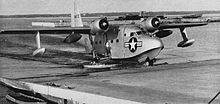 An XJR2F-1 prototype at NAS Patuxent River in the 1940s.
An XJR2F-1 prototype at NAS Patuxent River in the 1940s.
- XJR2F-1 - Prototype designation, two built.
- HU-16A (originally SA-16A) - USAF version
- HU-16A (originally UF-1) - Indonesian version
- HU-16B (originally SA-16A) - USAF version (modified with long wing)
- SHU-16B (modified HU-16B for Anti-Submarine Warfare) - export version
- HU-16C (originally UF-1) - US Navy version
- LU-16C (originally UF-1L) - US Navy version
- TU-16C (originally UF-1T) - US Navy version
- HU-16D (originally UF-1) - US Navy version (modified with long wing)
- HU-16D (originally UF-2) - German version (built with long wing)
- HU-16E (originally UF-1G) - US Coast Guard version (modified with long wing)
- HU-16E (originally SA-16A) - USAF version (modified with long wing)
- G-111 (originally SA-16A) - derived from USAF, JASDF, and German originals)
- CSR-110 - RCAF version
Operators
- Pakistan Air Force
- Pakistan Navy - Pakistan Naval Air Arm
Survivors
- HU-16B, AF Serial No. 51-5282, at the National Museum of the United States Air Force, Wright-Patterson AFB, Ohio. This was USAF's last operational HU-16. On 4 July 1973 it established a world record for twin-engine amphibians when it reached 32,883 feet and was transferred to the Air Force Museum two weeks later. [12]
- HU-16B, AF Serial No. 51-7176, on display at Coast Guard Air Station Clearwater, Florida. It was previously at the Pate Museum of Transportation in Cresson, Texas until its disassembly and relocation to CGAS Clearwater for restoration.[13]
- HU-16E, AF Serial No. 51-7251, at Dyess Linear Air Park, Dyess AFB, Texas
- HU-16C, US Navy Albatross displaying NAS Alameda and designation number 1911. Currently located on the north end of the field at Charles M. Schulz – Sonoma County Airport in reportedly flyable condition.
- Jimmy Buffett's Hemisphere Dancer, now the non-flying centerpiece of Universal Studios' Margaritaville Cafe in Orlando, Florida.
- Restored US Navy UF-1/HU-16C, Navy Bureau Number (BuNo) 131906, originally built June 1953
- Swimwear manufacturer Billabong operates a well-equipped Albatross for surf touring.
- Quiksilver also operates a similarly equipped Albatross for surf touring.
- Several private owners have Albatrosses equipped with sleeping quarters which can be used as an airborne recreational vehicle (sleep-aboard), either at an airport or on the water.
- HU-16B Albatross, AF Serial No. 51-7163, at Castle Air Museum adjacent to the (former Castle AFB, Atwater, California
- Two HU-16Bs of the Hellenic Air Force are on display at Dekelia (Tatoi) Air Base, north of Athens.
- HU-16E of the United States Navy (BuNo 141266) and an HU-16E of the U.S. Coast Guard (USCG 7236) at the National Museum of Naval Aviation at NAS Pensacola, Florida. These aircraft were the last operational HU-16s in their respective services.
- HU-16A, AF Serial No. 51-0022 at the Pima Air and Space Museum adjacent to Davis-Monthan AFB in Tucson, Arizona.
- HU-16E, USCG 7250, at CGAS Cape Cod at Massachusetts Military Reservation, Massachusetts. Currently being restored by CGAS personnel.
- HU-16E, USCG 1293, March Field Air Museum, March ARB, California
- HU-16B, AF Serial No. 51-1280, adjacent to the 58th Special Operations Wing compound at Kirtland AFB, New Mexico.
- HU-16E, USCG 7247, at CGAS Elizabeth City, North Carolina.
- HU-16B, N44HQ, owned and operated by Row 44 and equipped with in-flight WiFi as a test and marketing tool.
- SHU-16B, in Chilean Air Force colors as part of the static exhibition at the Museo Aeronáutico in Santiago de Chile
- HU-16B at Warfield Air National Guard Base, in Baltimore, Maryland.
- HU-16 at Jimmy Doolittle Air & Space Museum, Travis Air Force Base, Fairfield, California
- HU-16 of the Republic of China Air Force at Chung Cheng Aviation Museum, Taipei, Taiwan
- HU-16 "1012" of the Republic of China Air Force at Chiayi Air Base, Chiayi, Taiwan
- HU-16 of the Philippine Air Force at Jesus Villamor Air BaseMuseum, Pasay, Philippines
- SA-16A, Museu Aeroespacial in Rio de Janeiro, Brazil
Specifications (HU-16B)
Data from Albatross - Amphibious Airborne Angel [14]
General characteristics
- Crew: 4-6
- Capacity: 10 passengers
- Length: 62 ft 10 in (19.16 m)
- Wingspan: 96 ft 8 in (29.47 m)
- Height: 25 ft 10 in (7.88 m)
- Wing area: 1035 ft²[15] (96.2 m²)
- Empty weight: 22,883 lb (10,401 kg)
- Loaded weight: 30,353 lb (13,797 kg)
- Max takeoff weight: 37,500 lb (17,045 kg)
- Powerplant: 2 × Wright R-1820-76 Cyclone 9 nine-cylinder single-row air-cooled radial engine, 1,425 hp (1,063 kW) each
- Fuel Capacity: 675 US Gallons (2,550 L) internally, plus 400 US Gal (1,512 L) in wingtip floats plus two 300 US Gallon (1,135 L) drop tanks
Performance
- Maximum speed: 205 knots (236 mph, 380 km/h)
- Cruise speed: 108 knots (124 mph, 200 km/h)
- Stall speed: 64 knots (74 mph, 119 km/h)
- Range: 2,478 nmi (2,850 mi, 4,589 km)
- Service ceiling: 21,500 ft (6,550 m)
- Rate of climb: 1,450 ft/min (7.4 m/s)
Armament
- None
Notable appearances in media
Main article: Aircraft in fiction#HU-16 AlbatrossSee also
- Related development
- Aircraft of comparable role, configuration and era
References
- ^ Pigott, Peter (2001). Wings across Canada: an illustrated history of Canadian aviation. Dundurn Press. p. 121. ISBN 1550024124.
- ^ Albatross Was a Maryland Air Guard Classic
- ^ http://www.history.navy.mil/avh-1910/PART10.PDF
- ^ 1951 USAF Serial Numbers. Joebaugher.com. Retrieved on 2010-11-25.
- ^ View topic - Albatross Plane Crash Site. Death-Valley.net. Retrieved on 2010-11-25.
- ^ Schlight, John, "The War in South Vietnam: The Years of the Offensive, 1965-1968 (The United States Air Force in Southeast Asia)", Office of Air Force History, United States Air Force, Washington, D.C., 1988, Library of Congress card number 88-14030, ISBN 0-912799-51-X, page 52.
- ^ United Press International, "Migs [sic] Shoot Down Unarmed Chinese Plane", Playground Daily News, Fort Walton Beach, Florida, Monday, 10 January 1966, Volume 19, Number 342, page 2.
- ^ Barnette, Michael, Images of America - Florida's Shipwrecks, Arcadia Publishing, Charleston, South Carolina, Portsmouth, New Hampshire, San Francisco, California, 2008, Library of Congress card number 2008921895, ISBN 978-0-7385-5413-6, page 122.
- ^ United Press International, "Coast Guard Plane Feared Lost in Gulf", Star-News, Pasadena, California, 6 March 1967.
- ^ Jacksjoint.com
- ^ "Accident description". Aviation Safety Network. http://aviation-safety.net/database/record.php?id=20091105-0. Retrieved 7 November 2009.
- ^ "Factsheets: Grumman HU-16B Albatross". National Museum of the US Air Force. Retrieved 7 October 2011.
- ^ https://www.piersystem.com/go/doc/586/1079423/-Media-Advisory-Clearwater-Coast-Guard-to-dedicate-restored-aircraft-celebrate-Centennial-of-Naval-Aviation
- ^ Dorr 1991, p.196.
- Dorr, Robert F. "Albatross - Amphibious Airborne Angel". Air International, October 1991, Vol. 41, No. 4. ISSN 0306-5634. pp. 193–201.
- Swanborough, Gordon and Peter M. Bowers. United States Navy Aircraft since 1911. London:Putnam, Second edition, 1976. ISBN 0 370 10054 9.
- Production listing, source for Variants section
- Flight test report http://www.eaa1000.av.org/fltrpts/albatross/albatross.htm
External links
- Historical Aircraft page on Northrop Grumman Web Site
- HU-16 history, including other designations
- The Grumman Albatross Site
- Summary at Coast Guard Historian's site
Grumman and Northrop Grumman aircraft Manufacturer
designationsG-1 (floats only) · G-2 (floats only) · G-3 · G-4 · G-5 · G-6 · G-7 · G-8 · G-9 · G-10 · G-11 · G-12 · G-13 · G-14 · G-15 · G-16 · G-17 · G-18 · G-19 · G-20 · G-21 · G-22 · G-23 · G-24 · G-25 · G-26 · G-27 · G-29 · G-30 · G-31 · G-32 · G-33 · G-34 · G-35 · G-36 · G-37 · G-38 · G-39 · G-40 · G-41 · G-42 · G-43 · G-44 · G-45 · G-46 · G-47 · G-48 · G-49 · G-50 · G-51 · G-52 · G-53 · G-54 · G-55 · G-56 · G-57 · G-58 · G-59 · G-60 · G-61 · G-62 · G-63 · G-64 · G-65 · G-66 · G-67 · G-68 · G-69 · G-70 · G-71 · G-72 · G-73 · G-74 · G-75 · G-76 · G-77 · G-78 · G-79 · G-80 · G-81 · G-82 · G-83 · G-84 · G-85 · G-86 · G-87 · G-88 · G-89 · G-90 · G-91 · G-92 · G-93 · G-94 · G-96 · G-97 · G-98 · G-98J · G-99 · G-100 · G-101 · G-102 · G-103 · G-104 · G-105 · G-106 · G-107 · G-108 · G-109 · G-110 · G-111 · G-112 · G-113 · G-114 · G-115 · G-116 · G-117 · G-118 · G-119 · G-120 · G-121 · G-122 · G-123 · G-124 · G-125 · G-126 · G-127 · G-128 · G-134 · G-159 · G-164 · G-191 · G-231 · G-234 · G-251 · G-262 · G-303 · G-426 · G-712 · G-1128 · G-1159
By role Piston fightersJet fightersF9F · F9F/F-9 · XF10F · F11F/F-11/F11F-1F · G-118 · F-111B · F-14
Attack/PatrolRecon/ScoutsUtility/TransportsCivil aircraftMallard · Ag Cat · Kitten · Tadpole · Gulfstream I · Gulfstream II
OthersApollo Lunar Module · EF-111 · X-29 · Q-8 · X-47A · X-47B
By name Ag Cat · Albatross · Avenger · Bearcat · Cougar · Duck · Fifi · Goose · Greyhound · Guardian · Gulfhawk III · Gulfstream I · Gulfstream II · Hawkeye · Hellcat · Intruder · Jaguar · Kitten · Mallard · Mohawk · Panther · Pegasus · Prowler · Skyrocket · Super Tiger · Tadpole · Tiger · Tigercat · Tomcat · Tracer · Tracker · Trader · Wildcat · Widgeon
USAAC/USAAF observation aircraft Observation O-1 • O-2 • XO-3 • XO-4 • O-5 • O-6 • O-7 • O-8 • O-9 • XO-10 • O-11 • O-12 • O-14 • XO-14 • XO-15 • XO-16 • O-17 • XO-18 • O-19 • YO-20 • XO-21 • O-22 • YO-23 • O-24 • O-25 • Y1O-26 • Y1O-27 • O-28 • O-29 • O-30 • O-31 • O-32 • Y1O-33 • O-34 • O-35 • XO-36 • O-37 • O-38 • O-39 • O-40 • Y1O-41 • O-42 • O-43 • XO-44 • O-45 • O-46 • O-47 • XO-48 • O-49 • YO-50 • YO-51 • O-52 • O-53 • YO-54 • YO-55 • O-56 • O-57 • O-58 • O-59 • O-60 • XO-61 • O-62 • XO-63
Observation Amphibian USN/USMC patrol aircraft designations 1923-1962 Patrol HallKeystonePN • P2N • P4N
LockheedPOSikorskyPS • P2S
LockheedPatrol Bomber XPBB • PB2B
LockheedSikorskyPBSVickers CanadaPatrol Torpedo Bomber HallUSN/USMC utility aircraft designations 1935–1955 Utility Stearman-HammondJHJK · J2K
JLLockheedJOFairchildFordJW · J2W
Utility transport SikorskyUSN/USMC utility aircraft designations 1955–1962 de Havilland Canada Grumman Piper Lockheed United States tri-service utility aircraft designations post-1962 Canadian Forces unified aircraft designations post-1968 100-125 126–150 151- Lists relating to aviation General Aircraft (manufacturers) · Aircraft engines (manufacturers) · Airlines (defunct) · Airports · Civil authorities · Museums · Registration prefixes · Rotorcraft (manufacturers) · TimelineMilitary Accidents/incidents Records Categories:- Seaplanes and flying boats
- Amphibious aircraft
- United States military utility aircraft 1940–1949
- United States Coast Guard Aviation
- Grumman aircraft
Wikimedia Foundation. 2010.



